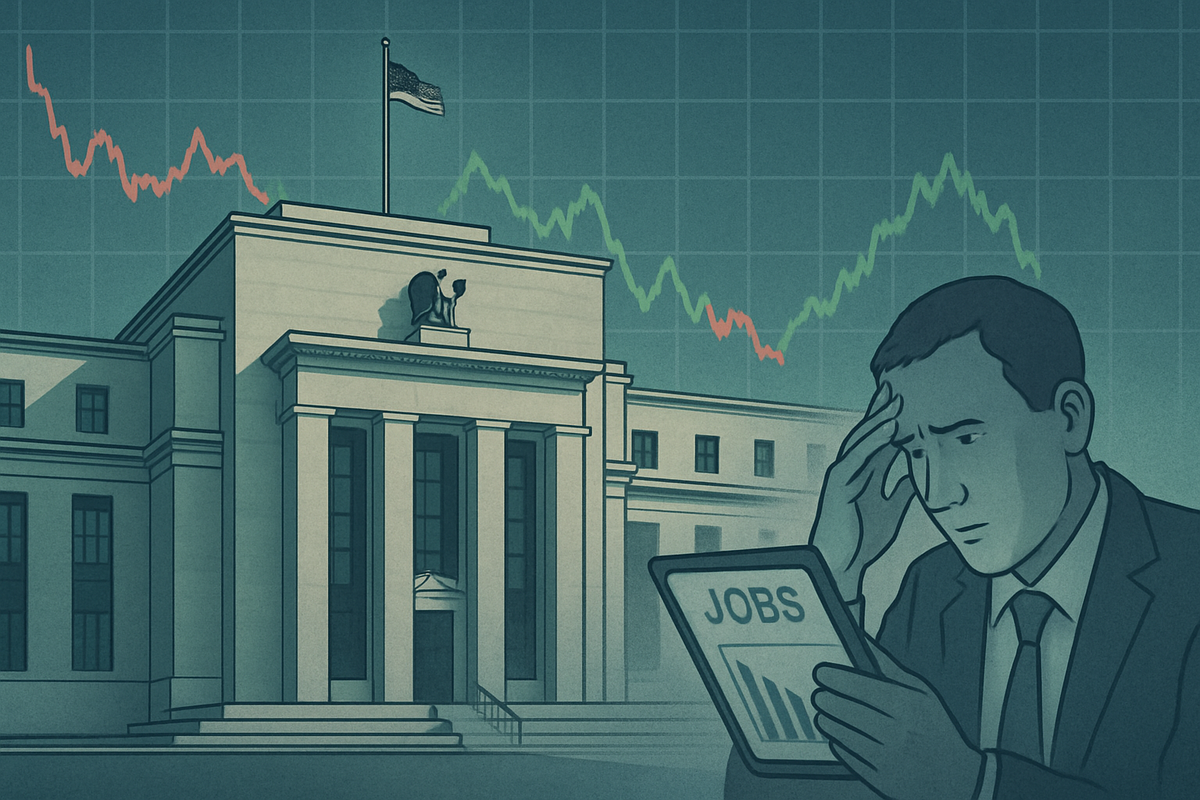
The financial world is abuzz following the Federal Reserve's latest monetary policy signals, which strongly hint at a potential interest rate cut in September. While the Federal Open Market Committee (FOMC) opted to keep rates unchanged at its recent meeting, Chairman Jerome Powell's subsequent remarks have been widely interpreted as a clear indication of a dovish shift, primarily driven by emerging weaknesses in the U.S. job market. This potential policy adjustment carries significant implications for investors, businesses, and the broader economy, as markets are already pricing in the likelihood of lower borrowing costs.
The immediate aftermath of these signals has seen a notable rally in equity markets, a decline in bond yields, and a weakening of the U.S. dollar. This market reaction underscores the anticipation of a more accommodative monetary policy, which could provide a much-needed stimulus to an economy showing signs of moderation. However, the Fed's cautious approach also highlights the delicate balance it must strike between supporting economic growth and managing inflation, especially with ongoing global trade tensions.
The Fed's Dovish Pivot: Unchanged Rates, Clear Signals
The Federal Reserve's Federal Open Market Committee (FOMC) concluded its meeting on July 30, 2025, by maintaining the benchmark federal funds rate in the target range of 4.25% to 4.50%. This decision marked the fifth consecutive meeting without a rate change, a level established in December 2024. However, the seemingly steady hand belied internal divisions, with two FOMC members, Michelle Bowman and Christopher Waller, dissenting in favor of an immediate 25-basis-point rate cut – a rare occurrence not seen since 1993. The FOMC's statement acknowledged a moderation in economic activity during the first half of the year, while still characterizing the labor market as solid despite "somewhat elevated" inflation.
The true pivot came on August 22, 2025, when Chairman Jerome Powell delivered a highly anticipated speech at the Jackson Hole Economic Symposium. Powell's remarks, though subtly phrased, were unequivocally dovish. He stated that "with policy in restrictive territory, the baseline outlook and the shifting balance of risks may warrant adjusting our policy stance," emphasizing a growing concern over economic weakening rather than a sustained increase in inflation. This statement was widely interpreted by financial markets as a strong signal for a rate cut at the upcoming September 16-17, 2025, FOMC meeting. Following his speech, the implied probability of a 25-basis-point rate cut in September, as tracked by the CME FedWatch tool, surged from approximately 70-75% to 85-91.5%.
A primary driver behind this potential policy shift is the emerging weakness in the U.S. job market. Powell specifically highlighted rising "downside risks to employment," describing the labor market as being in a "curious kind of balance" due to a slowdown in both the supply of and demand for workers. Recent government data has reinforced these concerns, with the July jobs report showing a sharp slowdown in hiring, adding only 73,000 non-farm payrolls, alongside significant downward revisions to May and June figures. The unemployment rate also ticked up to 4.2% in July. Powell warned that if these risks materialize, they could quickly lead to "sharply higher layoffs and rising unemployment." Furthermore, GDP growth slowed considerably in the first half of 2025 to an annual pace of 1.2%, roughly half of the 2.5% rate seen in 2024, largely attributed to a slowdown in consumer spending.
The initial market reaction to Powell's dovish signals was swift and pronounced. U.S. benchmark equity indices, including the Dow Jones Industrial Average (DJIA), S&P 500 (SPX), and Nasdaq Composite (IXIC), rallied significantly, with gains of up to 2%. This indicates that markets are actively pricing in the likelihood of lower borrowing costs, which typically boosts corporate earnings and investor sentiment. Concurrently, the U.S. benchmark 10-year Treasury yields crashed by 1.7%, and the rate-sensitive two-year Treasury yield fell by nearly 10 basis points, reflecting increased investor confidence in an impending rate cut. The U.S. dollar also weakened against a basket of major currencies, dropping approximately 0.93%, which could have implications for international trade and capital flows.
Who Wins and Who Loses from a Rate Cut?
A Federal Reserve rate cut, particularly one driven by concerns over economic slowdown and a softening job market, creates a distinct landscape of winners and losers across various sectors and companies. Generally, lower interest rates reduce borrowing costs, making it cheaper for businesses to expand and for consumers to finance purchases, which can stimulate economic activity.
Potential Winners:
- Growth Stocks and Technology Companies: Companies that rely heavily on future earnings growth and often require significant capital investment tend to benefit from lower interest rates. Technology giants like Apple (NASDAQ: AAPL), Microsoft (NASDAQ (MSFT)), and Amazon (NASDAQ: AMZN), which often fund innovation and expansion through debt, could see their borrowing costs decrease, boosting profitability. Furthermore, lower discount rates used in valuation models make their future earnings streams more valuable today, potentially driving up their stock prices.
- Housing and Real Estate: A rate cut typically translates to lower mortgage rates, making homeownership more affordable and stimulating demand. Homebuilders such as D.R. Horton (NYSE: DHI) and Lennar (NYSE: LEN), as well as real estate investment trusts (REITs) like Simon Property Group (NYSE: SPG), could see increased activity and improved financial performance. Consumers are more likely to take out new mortgages or refinance existing ones, benefiting the entire housing ecosystem.
- Consumer Discretionary: Sectors that thrive on consumer spending, such as retail, automotive, and leisure, often get a boost from lower interest rates. When borrowing costs for big-ticket items like cars or home renovations decrease, consumers are more inclined to spend. Companies like Tesla (NASDAQ: TSLA), Starbucks (NASDAQ: SBUX), and major airlines could see increased demand.
- Companies with High Debt Loads: Businesses carrying substantial debt can significantly benefit from lower interest rates as their interest payments decrease, freeing up cash flow. This could be particularly impactful for highly leveraged companies across various industries, improving their balance sheets and potentially their credit ratings.
Potential Losers:
- Banks and Financial Institutions: While lower rates can stimulate lending activity, they often compress net interest margins (NIMs) for banks. The difference between what banks earn on loans and what they pay on deposits shrinks, potentially impacting profitability. Major banks like JPMorgan Chase (NYSE: JPM), Bank of America (NYSE: BAC), and Wells Fargo (NYSE: WFC) could face headwinds on their core lending operations.
- Value Stocks and Dividend Payers: In a low-interest-rate environment, the appeal of stable, dividend-paying stocks can diminish as investors seek higher returns in growth-oriented assets. While still offering income, their relative attractiveness compared to bonds or growth stocks might decrease.
- Savers and Fixed-Income Investors: Individuals relying on interest income from savings accounts, money market funds, or certificates of deposit (CDs) will likely see their returns diminish. Similarly, investors holding existing bonds may see the value of their holdings decrease as new bonds are issued with lower yields, making older, higher-yielding bonds less attractive on the secondary market.
- U.S. Dollar Strength: As the Federal Reserve cuts rates, the U.S. dollar tends to weaken against other major currencies. This can make U.S. exports cheaper and imports more expensive, which is generally good for multinational corporations that export goods but can be a disadvantage for companies that rely heavily on imports.
The overall impact will depend on the magnitude and duration of the rate cuts, as well as the underlying economic conditions that prompted the Fed's action. Companies with strong balance sheets and adaptable business models will be better positioned to navigate these shifts.
Industry Impact and Broader Implications
The Federal Reserve's potential September rate cut, driven by concerns over the job market and slowing economic growth, signals a significant shift in monetary policy that will reverberate across various industries and have broader implications for the global economy. This move fits into a broader trend of central banks globally adopting more accommodative stances in response to economic uncertainties and persistent inflation challenges.
The most immediate industry impact will be felt in sectors sensitive to interest rates. The housing and construction industry is poised for a boost, as lower mortgage rates typically stimulate demand for homes and encourage new construction. This could provide a much-needed tailwind for homebuilders, real estate developers, and related industries like building materials and home furnishings. Conversely, the financial services sector, particularly traditional banks, may face pressure on their net interest margins, as the spread between lending and borrowing rates narrows. However, increased lending activity due to lower rates could partially offset this.
Beyond these direct impacts, the rate cut could have ripple effects on competitors and partners. For instance, a stronger housing market could benefit retailers that sell home goods and appliances, while a more robust consumer spending environment, fueled by lower borrowing costs, could lift the entire consumer discretionary sector. Companies with significant international operations might also see benefits from a weaker U.S. dollar, as their exports become more competitive and foreign earnings translate into more dollars.
From a regulatory and policy perspective, this potential rate cut underscores the Fed's commitment to its dual mandate of maximum employment and price stability. The emphasis on "downside risks to employment" suggests that the central bank is prioritizing job market health in its current decision-making. This proactive stance could be seen as an "insurance cut" to prevent a more severe economic downturn. Historically, the Fed has often cut rates in response to signs of economic weakening, aiming to provide stimulus before a recession fully takes hold. Comparisons can be drawn to periods in the late 1990s or early 2000s when the Fed adjusted rates to manage economic cycles and mitigate external shocks. The current environment, however, is complicated by ongoing global trade tensions and geopolitical uncertainties, which add layers of complexity to the Fed's policy calculus. The impact of new tariffs on inflation, while acknowledged by Powell as potentially "short-lived," remains a factor that the Fed must monitor closely.
What Comes Next
The immediate future will be dominated by the Federal Reserve's upcoming FOMC meeting in September. All eyes will be on whether the hinted-at rate cut materializes, and if so, its magnitude. A 25-basis-point cut is widely anticipated, but the market will also be scrutinizing the accompanying statement and Chairman Powell's press conference for clues about the Fed's future trajectory. Will this be a one-off "insurance cut," or the beginning of a more extended easing cycle? The answer will largely depend on incoming economic data, particularly employment figures, inflation readings, and indicators of consumer spending and business investment.
In the short term, businesses and investors should prepare for continued market volatility as economic data is released and interpreted through the lens of potential further rate adjustments. Companies may need to strategically pivot, adapting their capital expenditure plans and debt management strategies to capitalize on lower borrowing costs. For instance, businesses considering expansion or refinancing existing debt may find a more favorable environment. Conversely, those heavily reliant on interest income will need to explore alternative investment strategies.
Looking further ahead, the long-term possibilities include a sustained period of lower interest rates if economic growth remains subdued and inflation stays contained. This could lead to a prolonged boost for growth-oriented sectors and a continued search for yield by investors. However, there's also the potential for a "wait and see" approach from the Fed, where subsequent cuts are contingent on clear evidence of economic deterioration. Market opportunities may emerge in sectors that are particularly sensitive to interest rates, such as real estate, utilities, and certain segments of the technology industry. Challenges could arise for financial institutions and for the U.S. dollar if the rate differential with other major economies narrows significantly. Potential scenarios range from a soft landing, where the rate cut successfully averts a recession, to a more prolonged period of slow growth if underlying economic issues persist despite monetary easing.
Conclusion
The Federal Reserve's recent signals regarding a potential September rate cut mark a pivotal moment in current monetary policy, driven primarily by growing concerns over the health of the U.S. job market and broader economic moderation. The FOMC's decision to hold rates steady, followed by Chairman Powell's dovish remarks at Jackson Hole, has set the stage for a significant policy adjustment aimed at providing an "insurance cut" against downside risks. This shift has already triggered a notable market reaction, with equity markets rallying, bond yields falling, and the U.S. dollar weakening, as investors price in the likelihood of lower borrowing costs.
Moving forward, the market will be closely watching the September FOMC meeting for the confirmation of a rate cut and any indications of the Fed's future policy path. Key takeaways from this event include the Fed's increased focus on employment risks, the internal divisions within the FOMC, and the immediate positive impact on rate-sensitive sectors like technology and housing. Conversely, financial institutions and savers may face headwinds.
As the market moves forward, investors should remain vigilant, paying close attention to upcoming economic data, particularly job reports, inflation figures, and consumer sentiment indicators. These will be crucial in determining whether the Fed's initial rate cut is a standalone event or the precursor to a more extended easing cycle. Companies will need to adapt their financial strategies to this evolving interest rate environment, while individuals should reassess their savings and investment portfolios. The coming months will reveal the true significance and lasting impact of this potential policy pivot on the U.S. economy and global financial markets.





